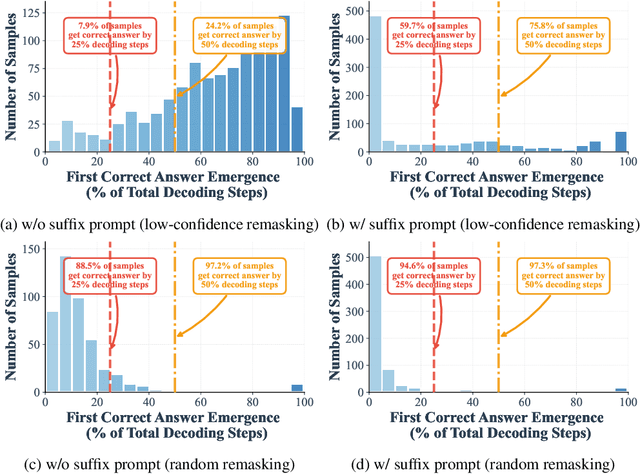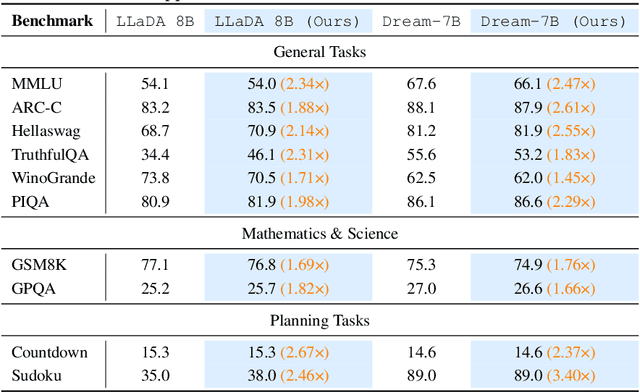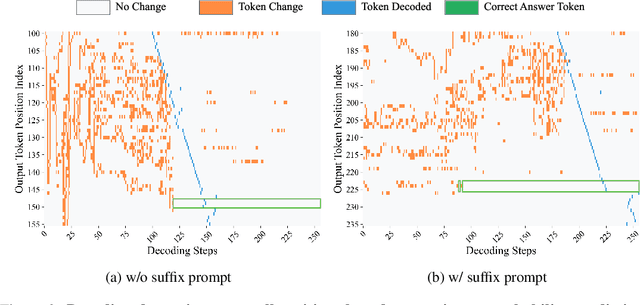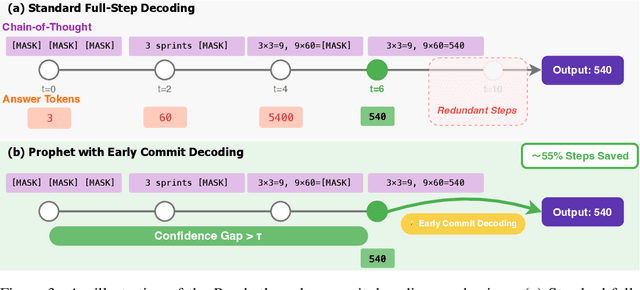Li Shen
Adaptive Defense against Harmful Fine-Tuning for Large Language Models via Bayesian Data Scheduler
Oct 31, 2025Abstract:Harmful fine-tuning poses critical safety risks to fine-tuning-as-a-service for large language models. Existing defense strategies preemptively build robustness via attack simulation but suffer from fundamental limitations: (i) the infeasibility of extending attack simulations beyond bounded threat models due to the inherent difficulty of anticipating unknown attacks, and (ii) limited adaptability to varying attack settings, as simulation fails to capture their variability and complexity. To address these challenges, we propose Bayesian Data Scheduler (BDS), an adaptive tuning-stage defense strategy with no need for attack simulation. BDS formulates harmful fine-tuning defense as a Bayesian inference problem, learning the posterior distribution of each data point's safety attribute, conditioned on the fine-tuning and alignment datasets. The fine-tuning process is then constrained by weighting data with their safety attributes sampled from the posterior, thus mitigating the influence of harmful data. By leveraging the post hoc nature of Bayesian inference, the posterior is conditioned on the fine-tuning dataset, enabling BDS to tailor its defense to the specific dataset, thereby achieving adaptive defense. Furthermore, we introduce a neural scheduler based on amortized Bayesian learning, enabling efficient transfer to new data without retraining. Comprehensive results across diverse attack and defense settings demonstrate the state-of-the-art performance of our approach. Code is available at https://github.com/Egg-Hu/Bayesian-Data-Scheduler.
Sparse Model Inversion: Efficient Inversion of Vision Transformers for Data-Free Applications
Oct 31, 2025Abstract:Model inversion, which aims to reconstruct the original training data from pre-trained discriminative models, is especially useful when the original training data is unavailable due to privacy, usage rights, or size constraints. However, existing dense inversion methods attempt to reconstruct the entire image area, making them extremely inefficient when inverting high-resolution images from large-scale Vision Transformers (ViTs). We further identify two underlying causes of this inefficiency: the redundant inversion of noisy backgrounds and the unintended inversion of spurious correlations--a phenomenon we term "hallucination" in model inversion. To address these limitations, we propose a novel sparse model inversion strategy, as a plug-and-play extension to speed up existing dense inversion methods with no need for modifying their original loss functions. Specifically, we selectively invert semantic foregrounds while stopping the inversion of noisy backgrounds and potential spurious correlations. Through both theoretical and empirical studies, we validate the efficacy of our approach in achieving significant inversion acceleration (up to 3.79 faster) while maintaining comparable or even enhanced downstream performance in data-free model quantization and data-free knowledge transfer. Code is available at https://github.com/Egg-Hu/SMI.
Unveiling the Power of Multiple Gossip Steps: A Stability-Based Generalization Analysis in Decentralized Training
Oct 09, 2025Abstract:Decentralized training removes the centralized server, making it a communication-efficient approach that can significantly improve training efficiency, but it often suffers from degraded performance compared to centralized training. Multi-Gossip Steps (MGS) serve as a simple yet effective bridge between decentralized and centralized training, significantly reducing experiment performance gaps. However, the theoretical reasons for its effectiveness and whether this gap can be fully eliminated by MGS remain open questions. In this paper, we derive upper bounds on the generalization error and excess error of MGS using stability analysis, systematically answering these two key questions. 1). Optimization Error Reduction: MGS reduces the optimization error bound at an exponential rate, thereby exponentially tightening the generalization error bound and enabling convergence to better solutions. 2). Gap to Centralization: Even as MGS approaches infinity, a non-negligible gap in generalization error remains compared to centralized mini-batch SGD ($\mathcal{O}(T^{\frac{c\beta}{c\beta +1}}/{n m})$ in centralized and $\mathcal{O}(T^{\frac{2c\beta}{2c\beta +2}}/{n m^{\frac{1}{2c\beta +2}}})$ in decentralized). Furthermore, we provide the first unified analysis of how factors like learning rate, data heterogeneity, node count, per-node sample size, and communication topology impact the generalization of MGS under non-convex settings without the bounded gradients assumption, filling a critical theoretical gap in decentralized training. Finally, promising experiments on CIFAR datasets support our theoretical findings.
Effective Policy Learning for Multi-Agent Online Coordination Beyond Submodular Objectives
Sep 26, 2025Abstract:In this paper, we present two effective policy learning algorithms for multi-agent online coordination(MA-OC) problem. The first one, \texttt{MA-SPL}, not only can achieve the optimal $(1-\frac{c}{e})$-approximation guarantee for the MA-OC problem with submodular objectives but also can handle the unexplored $\alpha$-weakly DR-submodular and $(\gamma,\beta)$-weakly submodular scenarios, where $c$ is the curvature of the investigated submodular functions, $\alpha$ denotes the diminishing-return(DR) ratio and the tuple $(\gamma,\beta)$ represents the submodularity ratios. Subsequently, in order to reduce the reliance on the unknown parameters $\alpha,\gamma,\beta$ inherent in the \texttt{MA-SPL} algorithm, we further introduce the second online algorithm named \texttt{MA-MPL}. This \texttt{MA-MPL} algorithm is entirely \emph{parameter-free} and simultaneously can maintain the same approximation ratio as the first \texttt{MA-SPL} algorithm. The core of our \texttt{MA-SPL} and \texttt{MA-MPL} algorithms is a novel continuous-relaxation technique termed as \emph{policy-based continuous extension}. Compared with the well-established \emph{multi-linear extension}, a notable advantage of this new \emph{policy-based continuous extension} is its ability to provide a lossless rounding scheme for any set function, thereby enabling us to tackle the challenging weakly submodular objectives. Finally, extensive simulations are conducted to validate the effectiveness of our proposed algorithms.
Beyond Two-Stage Training: Cooperative SFT and RL for LLM Reasoning
Sep 08, 2025Abstract:Reinforcement learning (RL) has proven effective in incentivizing the reasoning abilities of large language models (LLMs), but suffers from severe efficiency challenges due to its trial-and-error nature. While the common practice employs supervised fine-tuning (SFT) as a warm-up stage for RL, this decoupled two-stage approach limits interaction between SFT and RL, thereby constraining overall effectiveness. This study introduces a novel method for learning reasoning models that employs bilevel optimization to facilitate better cooperation between these training paradigms. By conditioning the SFT objective on the optimal RL policy, our approach enables SFT to meta-learn how to guide RL's optimization process. During training, the lower level performs RL updates while simultaneously receiving SFT supervision, and the upper level explicitly maximizes the cooperative gain-the performance advantage of joint SFT-RL training over RL alone. Empirical evaluations on five reasoning benchmarks demonstrate that our method consistently outperforms baselines and achieves a better balance between effectiveness and efficiency.
Diffusion Language Models Know the Answer Before Decoding
Aug 27, 2025



Abstract:Diffusion language models (DLMs) have recently emerged as an alternative to autoregressive approaches, offering parallel sequence generation and flexible token orders. However, their inference remains slower than that of autoregressive models, primarily due to the cost of bidirectional attention and the large number of refinement steps required for high quality outputs. In this work, we highlight and leverage an overlooked property of DLMs early answer convergence: in many cases, the correct answer can be internally identified by half steps before the final decoding step, both under semi-autoregressive and random remasking schedules. For example, on GSM8K and MMLU, up to 97% and 99% of instances, respectively, can be decoded correctly using only half of the refinement steps. Building on this observation, we introduce Prophet, a training-free fast decoding paradigm that enables early commit decoding. Specifically, Prophet dynamically decides whether to continue refinement or to go "all-in" (i.e., decode all remaining tokens in one step), using the confidence gap between the top-2 prediction candidates as the criterion. It integrates seamlessly into existing DLM implementations, incurs negligible overhead, and requires no additional training. Empirical evaluations of LLaDA-8B and Dream-7B across multiple tasks show that Prophet reduces the number of decoding steps by up to 3.4x while preserving high generation quality. These results recast DLM decoding as a problem of when to stop sampling, and demonstrate that early decode convergence provides a simple yet powerful mechanism for accelerating DLM inference, complementary to existing speedup techniques. Our code is publicly available at https://github.com/pixeli99/Prophet.
DynamiCare: A Dynamic Multi-Agent Framework for Interactive and Open-Ended Medical Decision-Making
Jul 03, 2025Abstract:The rise of Large Language Models (LLMs) has enabled the development of specialized AI agents with domain-specific reasoning and interaction capabilities, particularly in healthcare. While recent frameworks simulate medical decision-making, they largely focus on single-turn tasks where a doctor agent receives full case information upfront -- diverging from the real-world diagnostic process, which is inherently uncertain, interactive, and iterative. In this paper, we introduce MIMIC-Patient, a structured dataset built from the MIMIC-III electronic health records (EHRs), designed to support dynamic, patient-level simulations. Building on this, we propose DynamiCare, a novel dynamic multi-agent framework that models clinical diagnosis as a multi-round, interactive loop, where a team of specialist agents iteratively queries the patient system, integrates new information, and dynamically adapts its composition and strategy. We demonstrate the feasibility and effectiveness of DynamiCare through extensive experiments, establishing the first benchmark for dynamic clinical decision-making with LLM-powered agents.
AlphaDecay:Module-wise Weight Decay for Heavy-Tailed Balancing in LLMs
Jun 17, 2025Abstract:Weight decay is a standard regularization technique for training large language models (LLMs). While it is common to assign a uniform decay rate to every layer, this approach overlooks the structural diversity of LLMs and the varying spectral properties across modules. In this paper, we introduce AlphaDecay, a simple yet effective method that adaptively assigns different weight decay strengths to each module of an LLM. Our approach is guided by Heavy-Tailed Self-Regularization (HT-SR) theory, which analyzes the empirical spectral density (ESD) of weight correlation matrices to quantify "heavy-tailedness." Modules exhibiting more pronounced heavy-tailed ESDs, reflecting stronger feature learning, are assigned weaker decay, while modules with lighter-tailed spectra receive stronger decay. Our method leverages tailored weight decay assignments to balance the module-wise differences in spectral properties, leading to improved performance. Extensive pre-training tasks with various model sizes from 60M to 1B demonstrate that AlphaDecay achieves better perplexity and generalization than conventional uniform decay and other adaptive decay baselines.
MaskPro: Linear-Space Probabilistic Learning for Strict (N:M)-Sparsity on Large Language Models
Jun 15, 2025Abstract:The rapid scaling of large language models (LLMs) has made inference efficiency a primary bottleneck in the practical deployment. To address this, semi-structured sparsity offers a promising solution by strategically retaining $N$ elements out of every $M$ weights, thereby enabling hardware-friendly acceleration and reduced memory. However, existing (N:M)-compatible approaches typically fall into two categories: rule-based layerwise greedy search, which suffers from considerable errors, and gradient-driven combinatorial learning, which incurs prohibitive training costs. To tackle these challenges, we propose a novel linear-space probabilistic framework named MaskPro, which aims to learn a prior categorical distribution for every $M$ consecutive weights and subsequently leverages this distribution to generate the (N:M)-sparsity throughout an $N$-way sampling without replacement. Furthermore, to mitigate the training instability induced by the high variance of policy gradients in the super large combinatorial space, we propose a novel update method by introducing a moving average tracker of loss residuals instead of vanilla loss. Finally, we conduct comprehensive theoretical analysis and extensive experiments to validate the superior performance of MaskPro, as well as its excellent scalability in memory efficiency and exceptional robustness to data samples. Our code is available at https://github.com/woodenchild95/Maskpro.git.
TrojanTO: Action-Level Backdoor Attacks against Trajectory Optimization Models
Jun 15, 2025Abstract:Recent advances in Trajectory Optimization (TO) models have achieved remarkable success in offline reinforcement learning. However, their vulnerabilities against backdoor attacks are poorly understood. We find that existing backdoor attacks in reinforcement learning are based on reward manipulation, which are largely ineffective against the TO model due to its inherent sequence modeling nature. Moreover, the complexities introduced by high-dimensional action spaces further compound the challenge of action manipulation. To address these gaps, we propose TrojanTO, the first action-level backdoor attack against TO models. TrojanTO employs alternating training to enhance the connection between triggers and target actions for attack effectiveness. To improve attack stealth, it utilizes precise poisoning via trajectory filtering for normal performance and batch poisoning for trigger consistency. Extensive evaluations demonstrate that TrojanTO effectively implants backdoor attacks across diverse tasks and attack objectives with a low attack budget (0.3\% of trajectories). Furthermore, TrojanTO exhibits broad applicability to DT, GDT, and DC, underscoring its scalability across diverse TO model architectures.
 Add to Chrome
Add to Chrome Add to Firefox
Add to Firefox Add to Edge
Add to Edge